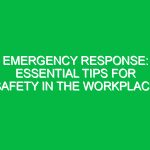Introduction
In the realm of Health, Safety, and Environment (HSE), a well-structured risk log serves as a critical tool for identifying, assessing, and mitigating potential hazards. An example of risk log encapsulates vital information that helps organizations maintain a safe and compliant working environment. This comprehensive article delves into the significance of risk logs within the HSE domain, presenting detailed examples and best practices to ensure success.
The necessity of a risk log cannot be overstated. It acts as a living document that evolves with the organization, providing insights into ongoing risks and facilitating proactive measures. By examining real-life scenarios and case studies, we will explore how effective risk logging can enhance safety protocols and environmental stewardship.
Understanding the Example of Risk Log
A risk log is essentially a record of all identified risks, their potential impacts, and the measures taken to manage them. The information is typically organized in a table format, allowing for easy reference and updates. A well-constructed risk log includes several critical components:
- Risk Identification: Clearly define each risk, detailing what it is and under what circumstances it may occur.
- Risk Assessment: Evaluate the likelihood and impact of each risk, often categorizing them as low, medium, or high.
- Mitigation Measures: Outline the strategies and actions to be taken to minimize or eliminate the risk.
- Responsible Parties: Assign individuals or teams accountable for managing each risk.
- Status Updates: Regularly review and update the log to reflect any changes in risk status or new risks that may emerge.
These elements combine to create a dynamic tool that empowers organizations to prioritize safety and compliance.
Key Components of an Effective Risk Log
To fully leverage the potential of an example of risk log, organizations should focus on several key components:
1. Risk Identification
Effective risk identification is the cornerstone of any risk management plan. Organizations must systematically identify risks that may impact health, safety, and environmental standards. This could involve:
- Conducting regular audits and inspections.
- Engaging employees in safety discussions to gather insights.
- Reviewing incident reports and near misses to identify recurring issues.
A hypothetical scenario can illustrate this step. Consider a construction site where workers report frequent slips and falls. By documenting these incidents, the team can identify inadequate flooring as a potential risk and take corrective actions.
2. Risk Analysis and Evaluation
Once risks are identified, organizations must assess their potential impact and likelihood. This step often employs qualitative and quantitative methods. For instance, a risk may be categorized using a risk matrix, which evaluates the probability of occurrence against the severity of impact.
3. Mitigation Strategies
After assessing risks, the next crucial step involves developing and implementing mitigation strategies. These strategies should be tailored to the specific risks identified and may include:
- Engineering controls, such as improved ventilation systems to reduce exposure to hazardous substances.
- Administrative controls, including revised safety policies or employee training programs.
- Personal Protective Equipment (PPE), ensuring employees have the necessary gear to protect against risks.
In a real-life example, a manufacturing plant identified chemical exposure as a significant risk. They implemented a rigorous training program on handling hazardous materials, significantly decreasing incidents.
4. Assigning Responsibility
Equally important is assigning responsibility for managing each identified risk. This ensures accountability and clarity in the risk management process. Organizations should designate specific individuals or teams to oversee risk mitigation efforts, regularly reviewing their progress.
5. Continuous Monitoring and Review
Risk management is an ongoing process. Regularly updating the risk log to reflect new information, changes in operations, or emerging risks is essential. This might involve setting up periodic reviews or audits to ensure the effectiveness of mitigation measures.
Benefits of Utilizing a Risk Log in HSE
The advantages of maintaining a comprehensive risk log are manifold. Here are some core benefits:
- Enhanced Safety: A proactive approach to risk management significantly reduces workplace accidents and incidents.
- Regulatory Compliance: Adhering to legal requirements and industry standards is streamlined through effective documentation.
- Improved Communication: A centralized risk log fosters better communication among teams regarding potential hazards and safety measures.
- Informed Decision-Making: Data from the risk log provides valuable insights for management when making safety and operational decisions.
Real-Life Examples of Risk Logs in Action
To illustrate the practical application of risk logs, let’s examine two case studies from distinct industries.
Case Study 1: Construction Industry
In a bustling construction site, a risk log was implemented to track potential hazards such as falls, equipment malfunctions, and exposure to harmful materials. The project manager organized regular meetings to review the log, encouraging workers to report new risks.
One significant entry in the log highlighted the potential for scaffold collapses. Following this identification, the team reinforced training on scaffold usage and conducted daily inspections. As a result, the site saw a 30% reduction in related incidents over three months.
Case Study 2: Healthcare Sector
In a large hospital setting, a risk log was crucial for managing patient safety. Healthcare professionals documented incidents such as medication errors and equipment failures. The log helped identify patterns, revealing that certain medications were frequently misadministered.
In response, the hospital implemented a double-check system for medication distribution and provided additional training for nursing staff. This led to a significant decline in medication errors, demonstrating the log’s impact on improving patient safety and care quality.
Regulations and Standards Impacting Risk Logs
In the HSE domain, organizations must navigate a web of regulations that influence their risk management practices. Understanding these standards is vital for compliance and effective risk logging.
1. OSHA Standards
In the United States, the Occupational Safety and Health Administration (OSHA) sets forth regulations that require employers to maintain a safe working environment. This includes the need for risk assessments and documentation of hazards, making a risk log an essential component of compliance.
2. ISO 45001:2018
This international standard for occupational health and safety provides a framework for organizations to manage their safety risks. ISO 45001 emphasizes the importance of risk assessment and encourages organizations to maintain a risk log as part of their continuous improvement process.
Actionable Guidelines for Creating an Effective Risk Log
To maximize the effectiveness of a risk log, organizations can follow these actionable guidelines:
- Be Thorough: Ensure every potential risk is documented with sufficient detail.
- Involve Staff: Engage employees at all levels in identifying and assessing risks.
- Update Regularly: Set a schedule for reviewing and updating the risk log.
- Utilize Technology: Consider software solutions that can streamline the risk logging process and facilitate easier updates.
Conclusion
The importance of an example of risk log in promoting health, safety, and environmental sustainability cannot be overstated. It serves not only as a tool for compliance but also as a foundation for fostering a culture of safety within organizations. By systematically identifying, assessing, and managing risks, businesses can protect their employees, assets, and the environment.
As we navigate the complexities of risk management, it becomes increasingly clear that a proactive approach is essential. Embracing the principles outlined in this article will empower organizations to create safer workplaces and ensure compliance with regulations, ultimately contributing to a healthier society and planet.


